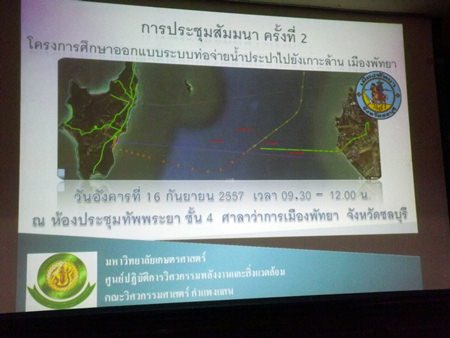Two-thirds of Koh Larn residents oppose plans to lay an undersea pipeline to bring drinking water to the island even though they overwhelmingly believe solving water-scarcity problems would benefit them, a new survey showed.
Consultants from Kasetsart University’s Energy and Environmental Engineering Center hired by Pattaya to do the feasibility study for the project said Sept. 16 that only 34.6% of respondents approve of any of three options being considered to solve long-running water-shortage problems.
Of the remaining 65.4%, people either opposed the project, were unsure or – in the case of 31% of those not in agreement with the idea – had “no comment.”
 A map was projected during the meeting, showing the 3 possible plans for a water pipeline from mainland Pattaya to Koh Larn.
A map was projected during the meeting, showing the 3 possible plans for a water pipeline from mainland Pattaya to Koh Larn.
The survey results deal a perplexing setback to Pattaya city officials who seemingly assumed that island residents would welcome any project solving the water scarcity problem. Fifty-three percent of mainland Pattaya residents asked the same questions approved of the plan.
The first of three options being considered by the city would see a pipeline run from the Banglamung water-treatment plant to the island over a distance of approximately 24.7 km. It would include installation of main water meter for Koh Larn’s supply. The price tag for the project is 495.1 million baht.
The project calls for pipe measuring 63 cm in diameter and faces no real obstacles until the final 2.7 km, where the undersea pipeline would run into a coral reef. That will require an environmental impact study lasting six months, at least.
Less-expensive options revealed in earlier hearings include a pipeline, using 50 cm pipe, from the Phothisamphan area to Koh Larn for 13.7 km at a cost of 288.2 million baht; and another from the Thappraya area to Koh Larn, again using 50 cm pipe, over 13 km for 227.7 million baht. That also includes construction of a storage tank on the coast.
The Koh Larn survey showed that 69.2 percent of residents were aware of the scarcity issue and 73.1 percent agreed that fixing the problem would have a positive impact on the island.
However, half of the respondents expressed concerns about the pipeline project’s impact on the environment, the cost, the amount of time needed to complete and whether it would provide enough water.
While the majority of mainlanders want to see the pipeline built, about half of them also expressed reservations about the environmental impact of dredging with half of respondents worrying about the mainland’s water supply once water is pumped to the island.
Water supply has been a growing problem as the popularity and population of the resort island grows. The city has an existing contract with the East Water Co. to run a desalinization plant on the island, but demand has outstripped supply, which currently stands at only 300 cu meters a day.
To supplement that, Koh Larn contracts with the Navy to ship water to Na Baan Pier and residents have collected their own rainwater to keep for use during dry season.
Koh Larn is home to 489 households and now attracts about 2 million visitors a year.




